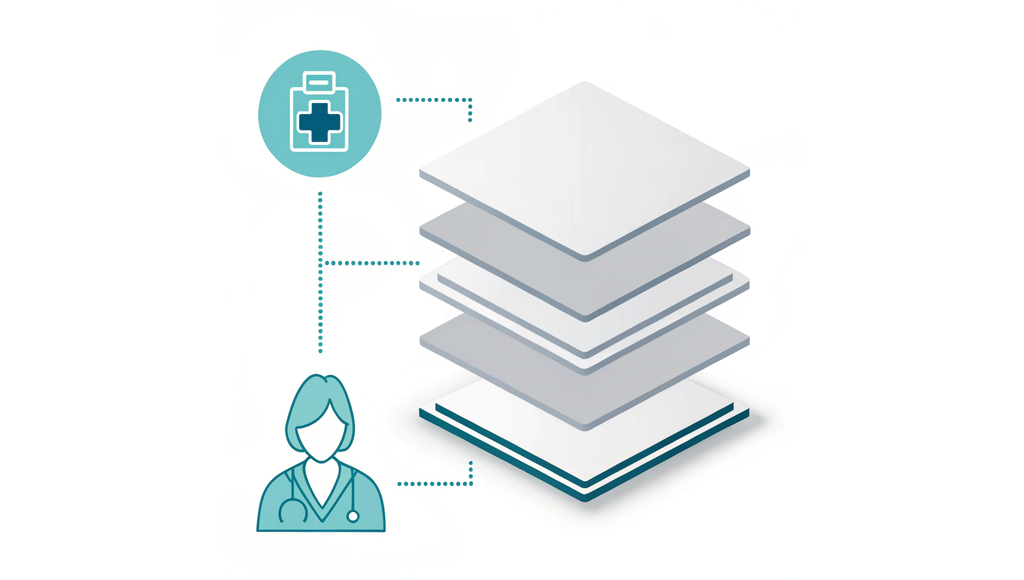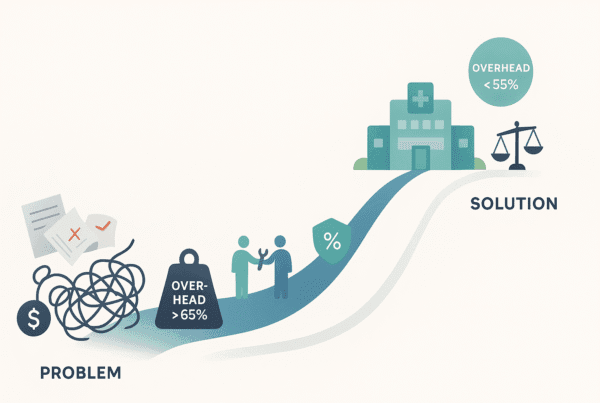
Learn how to calculate adjusted EBITDA for your medical practice selling to private equity or an MSO. This guide details common add-backs, normalization adjustments, and how to defend your numbers to buyers.
You’ve built a profitable practice, and your Profit & Loss statement reflects years of hard work. But when it comes time to sell, sophisticated buyers won’t value your business based on the net income on your tax return. They look deeper. They look for your practice’s true, ongoing earning power, a figure known as Normalized or Adjusted EBITDA.
If you are just starting to learn about practice valuation, it’s helpful to understand the complete picture. The process of normalization is a critical component of the overall valuation framework, which you can explore in our complete guide to healthcare practice valuation.
The core idea is straightforward. Buyers want to see what the practice’s profitability would look like under their ownership, stripped of any expenses or income unique to you. This is achieved through EBITDA normalization—a systematic process of “adjusting” your reported earnings. For those who need a refresher on the basics, you can find a primer on understanding healthcare EBITDA here.
This guide will walk you through exactly how that process works, what adjustments are common, and how to prepare your numbers for the tough scrutiny of a potential buyer.
The Most Common EBITDA Adjustments for Medical Practices
Normalization involves identifying and quantifying any expenses or income that are not essential for the day-to-day operations or are not expected to continue after the sale. These adjustments, often called “add-backs,” can significantly increase your valuation.
Here are the most critical adjustments we see in physician-owned practices.
1. Owner Compensation & Benefits
This is almost always the largest and most important adjustment for a physician-owned practice. You likely pay yourself a salary, bonuses, or distributions that aren’t aligned with what a buyer would pay a new medical director or associate physician.
- How it Works: We replace your total compensation (salary, benefits, auto lease, etc.) with a “fair market value” (FMV) salary for a physician in your specialty and role. If you pay yourself $500,000 but the FMV for a non-owner physician is $300,000, we “add back” the $200,000 difference to your EBITDA.
2. Personal and Discretionary Expenses
Physician-owners often run personal expenses through the business for tax purposes. While perfectly legal, these are not legitimate business operating costs and must be added back.
- Common Examples:
- Personal vehicle leases or expenses
- Family cell phone plans
- Spouse or family member salaries that are above market rates for the work performed
- Personal travel or entertainment disguised as business trips
- Club memberships or personal subscriptions
3. Non-Recurring or One-Time Costs
Your practice may have incurred significant expenses that are not expected to happen again. Because a buyer is valuing future cash flow, these one-time costs should be removed.
- Common Examples:
- Start-up costs for a new Electronic Medical Record (EMR) system
- Large, one-time legal settlements or professional fees
- Recruiting fees for a new physician
- Costs associated with relocating an office
- Major, non-routine repairs or renovations
4. Related-Party Transactions
If you own the building your practice operates in through a separate LLC, you must adjust the rent to a fair market rate.
- How it Works: An independent appraisal determines the market rent. If your practice pays your LLC $100,000 in annual rent but the market rate is $125,000, you subtract $25,000 from EBITDA. Conversely, if you pay above-market rent, the excess is added back.
5. Non-Recurring Income
Just as one-time expenses are added back, any one-time income must be subtracted from your earnings to avoid artificially inflating your profitability.
- Common Examples:
- Government grants like the Paycheck Protection Program (PPP) or other COVID-19 relief funds.
- A large, one-time settlement received from a lawsuit.
- Income from the sale of a major piece of equipment.
A Step-by-Step Example: Normalizing a Practice’s EBITDA
Let’s see how this works in practice. Consider a mid-sized orthopedic practice with a reported EBITDA of $700,000. Applying the normalization adjustments reveals a much healthier financial picture.
| Item | Amount (USD) | SovDoc’s Rationale for Adjustment |
|---|---|---|
| Reported EBITDA | $700,000 | Starting point from the annual P&L statement. |
| Add-back: Excess Owner Compensation | +$150,000 | The owner was paid $450,000. Market analysis shows a fair salary is $300,000. The difference is added back. |
| Add-back: Practice-Funded Personal Travel | +$35,000 | The owner expensed family vacations. These are not legitimate business expenses and are added back. |
| Subtract: Below-Market Rent | -$25,000 | The practice pays rent to the owner’s real estate LLC. Market rent is $25,000 higher, so this amount is subtracted. |
| Add-back: One-Time Legal Settlement | +$40,000 | The practice had a one-time legal expense related to a contract dispute that will not recur. |
| Subtract: Non-Recurring Grant Income | -$30,000 | The practice received a one-time state grant for technology adoption. This income is not ongoing. |
| Normalized EBITDA | $870,000 | The true, recurring annual cash flow a buyer can expect. |
The impact on valuation is immense. This $170,000 increase in Normalized EBITDA, at a 7x multiple, adds $1,190,000 to the practice’s enterprise value. This single exercise can be the difference between a good exit and a life-changing one.
A Buyer’s Perspective: Preparing for Scrutiny
You can’t just create a list of add-backs and expect a buyer to accept them. Every adjustment will be rigorously challenged during financial due diligence, a process often formalized in a Quality of Earnings (QoE) analysis.
Your credibility during this phase is paramount.
1. Documentation is Everything: For every adjustment, you need a clear paper trail. Provide invoices for one-time legal fees, market data for salaries, and lease agreements for rent adjustments. An adjustment without justification is just a claim; an adjustment with proof is a fact.
2. Use Third-Party Benchmarks: Don’t guess what a fair market salary is. Use objective, third-party compensation surveys (e.g., from MGMA or SullivanCotter). The same goes for rent—a commercial real estate broker’s opinion of value is more credible than your own.
3. Be Realistic, Not Aggressive: Buyers see hundreds of deals. They know what legitimate add-backs look like. Overly aggressive or questionable adjustments will raise red flags and erode trust. It is better to have a conservative, defensible list of adjustments than an inflated, aggressive one that gets torn apart in diligence.
How SovDoc Turns Normalization into a Strategic Advantage
EBITDA normalization is more than an accounting exercise. It is the foundation of your entire M&A narrative. When done correctly, it frames your practice’s financial story in the most powerful way possible.
At SovDoc, this process is a core part of how we prepare a medical practice for sale. Our team builds your financial model with the same rigor that a private equity firm would, ensuring that every adjustment is justifiable and positioned to maximize value.
We don’t just find add-backs; we build a defensible case for your practice’s true earnings potential, which becomes the bedrock of our negotiation strategy. This level of detail is a standard component of our healthcare financial modeling services.
Understanding your true earning power is the first step toward a successful exit. By normalizing your EBITDA, you gain a clear, buyer’s-eye view of what your practice is really worth.
Ready to understand your practice’s true earning power? Contact SovDoc for a confidential analysis and see how professional EBITDA normalization can transform your valuation.
Frequently Asked Questions
What is EBITDA normalization and why is it important when selling a healthcare practice?
EBITDA normalization is the process of adjusting a medical practice’s earnings to reflect its true, ongoing earning power by removing any expenses or income that are not expected to continue under new ownership. This is important because sophisticated buyers want to see the practice’s profitability stripped of any unique or non-recurring items, ensuring an accurate valuation based on sustainable cash flow.
What are some common adjustments made during EBITDA normalization for physician-owned practices?
Common adjustments include: 1) Owner compensation & benefits — adjusting the owner’s pay to fair market value for a non-owner physician; 2) Personal and discretionary expenses — adding back personal costs run through the business like family travel or vehicle leases; 3) Non-recurring or one-time costs — removing costs not expected to recur such as legal settlements or recruiting fees; 4) Related-party transactions — adjusting rent paid to owner’s real estate LLC to fair market rent; and 5) Non-recurring income — subtracting one-time income like government grants.
How does adjusting owner compensation impact EBITDA normalization?
Owner compensation often represents the largest adjustment. If the owner pays themselves a salary above what a buyer would pay a non-owner physician, the excess amount is added back to EBITDA. For example, if an owner pays themselves $500,000 but the fair market salary for their role is $300,000, the $200,000 difference is added back, leading to a higher normalized EBITDA and increased practice valuation.
What should sellers do to prepare their EBITDA adjustments for buyer scrutiny?
Sellers should document every adjustment with clear evidence like invoices, lease agreements, and third-party market data. Using reputable benchmarks from sources such as MGMA or SullivanCotter for salaries and independent real estate appraisals for rent helps validate claims. It’s critical to be realistic and conservative with adjustments, as aggressive or unfounded add-backs can damage credibility during financial due diligence and quality of earnings analysis.
How can EBITDA normalization influence the valuation of a healthcare practice?
Normalization can significantly increase the reported EBITDA, which directly impacts the practice’s enterprise value. For example, a $170,000 increase in normalized EBITDA at a 7x valuation multiple adds over $1.1 million to the practice’s selling price. Thus, properly executed EBITDA normalization can be the difference between a good exit and a life-changing one for the seller.



